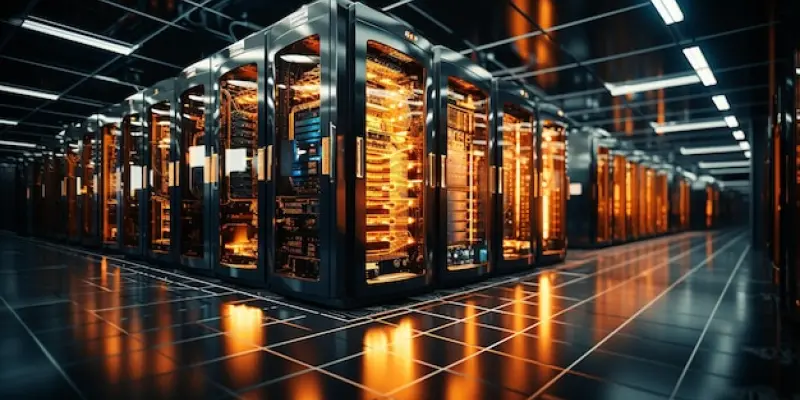The latest advancements in artificial intelligence (AI) are driving substantial changes in the design and infrastructure of data centers. As new AI technologies like ChatGPT, launched in 2022, continue to emerge, the demand for more powerful and efficient data centers has skyrocketed. These cutting-edge technologies necessitate data centers to evolve from traditional methods to meet their intensive computational needs and heightened power demands. The burgeoning requirements of AI are fundamentally reshaping how data centers are planned, built, and operated, ultimately influencing future landscapes.
The Shift from CPUs to GPUs
One of the most significant changes in data center infrastructure involves the transition from using CPUs to GPUs. GPUs are far superior in handling the parallel computations necessary for AI processing, and this shift has necessitated substantial redesigns in data center power and cooling systems. To support these high-performance components, facilities have increasingly focused on building robust power infrastructures, advanced cooling systems, and providing ample space. The switch to GPUs is not purely an incremental upgrade but a transformational change requiring a complete overhaul of relevant systems.
The computational power required for AI workloads, especially in AI model training, is immense and demands synchronized GPU arrays that can consume significant energy, typically ranging between 90 to 130 kW per rack. Traditional CPU-based data centers were not initially designed to manage such high energy consumption. By comparison, inference operations, which involve executing tasks with trained models, consume less power but still exceed traditional workloads, using between 15 to 40 kW per rack. The magnitude of power consumption underscores the growing necessity for data centers to adapt their power infrastructures accordingly.
Cooling Challenges and Innovations
As data centers transition to GPU usage, the inadequacy of traditional air-based cooling systems has been further magnified. GPUs’ high power density requires cutting-edge cooling solutions to efficiently dissipate the heat they generate, which traditional systems cannot achieve. This situation has driven the development and implementation of liquid cooling systems, which can manage heat directly from GPU units more efficiently than air-based methods. The transition to liquid cooling marks a significant evolutionary step in cooling technology, aligning data center infrastructure with AI’s rigorous requirements.
A hybrid approach to cooling is becoming more prevalent as data centers increasingly combine traditional air-based cooling for certain components and modern liquid cooling systems for others. This composite method ensures that all components operate efficiently within the required safe temperature ranges, thus maintaining the operational integrity of AI workloads. Balancing these two systems helps optimize performance and reliability. Implementing innovative cooling solutions has become a cornerstone for modern data centers in their quest to support AI workloads better.
Power Infrastructure and Energy Consumption
The power demands of data centers designed to support AI far exceed those of their traditional counterparts. Future data centers must prepare for extremely high initial power requirements, potentially exceeding 100 MW per building, with scalability up to 1 GW per campus. The growing power demands call for higher voltage systems that can address both electrical consumption and thermal limitations. These advancements are crucial to ensuring that AI data centers operate reliably and efficiently, handling the immense workloads without faltering.
Notably, the rise of Nvidia GPUs, despite being more cost-effective and performant, has contributed to an overall increase in electrical power consumption. Consequently, data centers must adapt to these rising demands by continually developing their power and cooling systems to keep up with evolving AI technologies. The continuous enhancement of power infrastructures and cooling solutions remains essential to maintaining the reliability and efficiency of these AI-powered data centers. This ongoing evolution is vital for effectively supporting AI’s growing workloads.
Construction and Location Preferences
Constructing AI data centers has adapted to meet the specific requirements necessitated by AI workloads. Training facilities, in particular, need massive power and networking capabilities, often requiring the construction of entirely new sites. These new facilities are designed from the ground up to support AI’s immense power and computational needs. On the other hand, inference workloads can be managed more flexibly through retrofitting and modifying existing data centers. This approach provides some adaptability and cost-efficiency, enabling the reuse of existing infrastructure with necessary upgrades.
Location preferences for AI data centers have also been evolving due to their substantial energy requirements. Innovations in establishing these centers in remote areas with abundant energy resources, repurposing decommissioned power plants, and developing dedicated power plants are shaping a dramatic shift in energy market dynamics. These strategies address both energy availability and cost, supporting AI’s energy-intensive operations. This evolving approach to location selection is instrumental in ensuring that AI data centers can meet their extensive power needs sustainably and economically.
Industry Collaboration and Future Outlook
The most recent advancements in artificial intelligence (AI) are triggering significant transformations in the design and infrastructure of data centers. With the emergence of new AI technologies such as ChatGPT, which was launched in 2022, there has been a dramatic increase in demand for more powerful and efficient data centers. These advanced technologies require data centers to move away from traditional methods in order to meet the high computational needs and increased power demands. The growing requirements of AI are leading to a fundamental reshaping in how data centers are planned, designed, and operated. This shift is not just about upgrading hardware and increasing power capacity; it also involves implementing more sophisticated cooling systems, optimizing space utilization, and integrating advanced cybersecurity measures. The continual evolution of AI technologies means data centers must be more adaptable and scalable. Ultimately, these changes are set to redefine the future landscape of data center infrastructure, shaping how they will be built and operated to support the burgeoning AI environment.

